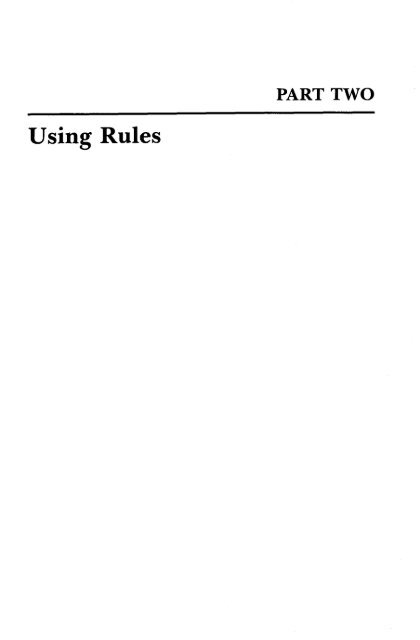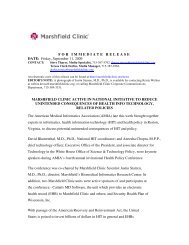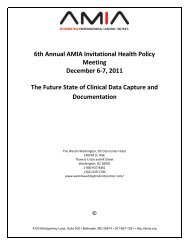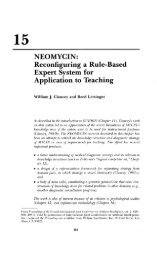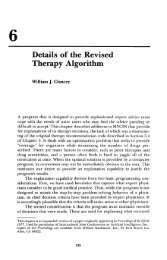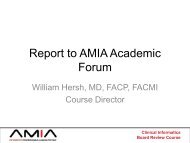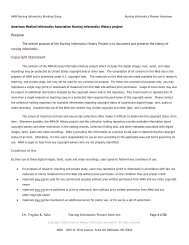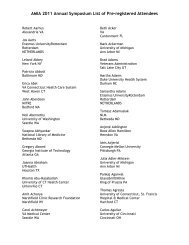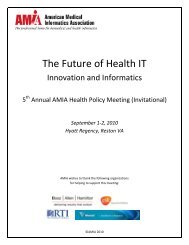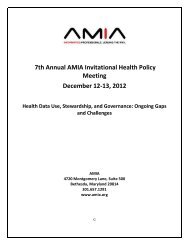Chapter 3 - People
Chapter 3 - People
Chapter 3 - People
You also want an ePaper? Increase the reach of your titles
YUMPU automatically turns print PDFs into web optimized ePapers that Google loves.
PARTTWOUsing Rules
3The EvolutionRule Formof MYCIN’sThere is little doubt that the decision to use rules to encode infectiousdisease knowledge in the nascent MYCIN system was largely influenced byour experience using similar techniques in DENDRAL. However, as mentionedin <strong>Chapter</strong> 1, we did experiment with a semantic network representationbefore turning to the production rule model. The impressivepublished examples of Carbonell’s SCHOLAR system (Carbonell, 1970a;1970b), with its ability to carry on a mixed-initiative dialogue regardingthe geography of South America, seemed to us a useful model of the kindof rich interactive environment that would be needed for a system to advisephysicians.Our disenchantment with a pure semantic network representation ofthe domain knowledge arose for several reasons as we began to work withCohen and Axline, our collaborating experts. First, the knowledge of infectiousdisease therapy selection was ill-structured and, we found, difficultto represent using labeled arcs between nodes. Unlike South Americangeography, our domain did not have a clear-cut hierarchical organization,and we found it challenging to transfer a page or two from a medicaltextbook into a network of sufficient richness for our purposes. Of particularimportance was our need for a strong inferential mechanism thatwould allow our system to reason about complex relationships among diverseconcepts; there was no precedent for inferences on a semantic netthat went beyond the direct, labeled relationships between nodes.1Perhaps the greatest problem with a network representation, and thegreatest appeal of production rules, was our gradually recognized need todeal with small chunks of domain knowledge in interacting with our expertcollaborators. Because they were not used to dissecting their clinical reasoningprocesses, it was totally useless to ask them to "tell us all that youknow." However, by discussing specific difficult patients, and by encour-IThe PROSPECTOR system Duda et al., 1978a; 1978b), which was developed shortly afterMYCIN, uses a network of inferential relations--a so-called inference net--to combine a semanticnetwork with inference rules.55
56 The Evolution of MYCIN’s Rule Formaging our collaborators to justify their questions or decisions, those of uswho were not expert in the field began to tease out "nuggets" of domainknowledge--individual inferential facts that the experts identified as pertinentfor problem solving in the domain. By encoding these facts as individualproduction rules, rather than attempting to decompose them intonodes and links in a semantic network, we found that the experts wereable to examine and critique the rules without difficulty. This transparencyof the knowledge base, coupled with the inherent modularity of knowledgeexpressed as rules, allowed us to build a prototype system quickly andallowed the experts to identify sources of performance problems with relativeease. They particularly appreciated having the ability to observe theeffects of chained reasoning based on individual rules that they themselveshad provided to us. In current AI terminology, the organization of knowledgewas not object-centered but was centered around inferential processes.Our early prototype rapidly diverged from DENDRAL because wewere driven by different performance goals and different characteristicsof the knowledge in the domain. Of particular importance was the needto deal with inexact inference; unlike the categorical conclusions in DEN-DRAL’s rules, the actions in MYCIN’s productions were typically conclusionsabout the state of the world that were not known with certainty. Wesoon recognized the need to accumulate evidence regarding alternativehypotheses as multiple rules lent credence to the conclusions. The needfor a system to measure the weight of evidence of competing hypotheseswas not surprising; it had also characterized conventional statistical approachesto computer-based medical decision making. Our certainty factormodel, to which we refer frequently throughout this book (and which isthe subject of Part Four), was developed in response to our desire to dealwith uncertainty while attempting to keep knowledge modular and in rules.The absence of complete certainty in most of our rules meant that weneeded a control structure that would consider all rules regarding a givenhypothesis and not stop after the first one had succeeded. This need forexhaustive search was distinctly different from control in DENDRAL,where the hierarchical ordering of rules was particularly important forcorrect prediction and interpretation (see <strong>Chapter</strong> 2). Because rule orderingwas not important in MYCIN, the modularity of rules was heightened;the experts did not need to worry about ordering the rules they gave usor 2 about other details of control.Another important distinction between the reasoning paradigms ofDENDRAL and MYCIN was recognized early. DENDRAL generatedhypotheses regarding plausible chemical structures and used its rule set to2The arbitrary order of MYCIN’s rules did lead to some suboptimal performance characteristics,however. In particular, the ordering of questions to the user often seemed unfocused.It was for this reason that the MAINPROPS (later known as INITIALDATA) feature wasdevised (see <strong>Chapter</strong> 5), and the concept of meta-rules was developed to allow rule selectionand ordering based on strategic knowledge of the domain (see <strong>Chapter</strong> 28). The developmentof prototypes in CENTAUR (<strong>Chapter</strong> 23) was similarly motivated.
Design Considerations 57test these hypotheses and to select the best ones. Thus DENDRAL’s controlscheme involved forward invocation of rules for the last phase of the plangenerate-and-testparadigm. On the other hand, it was unrealistic for MY-CIN to start by generating hypotheses regarding likely organisms or combinationsof pathogens; there were no reasonable heuristics for pruningthe search space, and there was no single piece of orienting informationsimilar to the mass spectrum, which provided the planning information toconstrain DENDRAL’s hypothesis generator. Thus MYCIN was dependenton a reasoning model based on evidence gathering, and its rules were usedto guide the process of input data collection. Because we wanted to avoidproblems of natural language understanding, and also did not want toteach our physician users a specialized input language, we felt it was unreasonableto ask the physician to enter some subset of the relevant patientdescriptors and then to have the rules fire in a data-driven fashion. Instead,we chose a goal-directed control structure that allowed MYCIN to ask therelevant questions and therefore permitted the physician to respond, ingeneral, with simple one-word answers. Thus domain characteristics ledto forward-directed use of the generate-and-test paradigm in DENDRALand to goal-directed use of the evidence-gathering paradigm in MYCIN.We were not entirely successful in putting all of the requisite medicalknowledge into rules. <strong>Chapter</strong> 5 describes the problems encountered intrying to represent MYCIN’s therapy selection algorithm as rules. Becausetherapy selection was initially implemented as LISP code rather than inrules, MYCIN’s explanation system was at that time unable to justify specifictherapy decisions in the same way it justified its diagnostic decisions.This situation reflects the inherent tension between procedural and production-basedrepresentation of this kind of algorithmic knowledge. Theneed for further work on the problem was clear. A few years later Clanceyassumed the challenge of rewriting the therapy selection part of MYCINso that appropriate explanations could be generated for the user. We wereunable to encode the entire algorithm in rules, however, and instead settledon a solution reminiscent of the generate-and-test approach used in DEN-DRAL: rules were used to evaluate therapeutic hypotheses after they hadbeen proposed (generated) by an algorithm that was designed to supportexplanations of its operation. This clever solution, described in <strong>Chapter</strong> 6,seemed to provide an optimal mix of procedural and rule-based knowledge.3.1Design ConsiderationsMany of’ the decisions that led to MYCIN’s initial design resulted from apragmatic response to perceived demands of physicians as computer users.Our perceptions were largely based on our own intuitions and observations
58 The Evolution of MYCIN’s Rule Formabout problems that had limited the success of previous computer-basedmedical decision-making systems. More recently we have undertaken forrealstudies of physician attitudes (<strong>Chapter</strong> 34), and the data that resulted,coupled with our prior experience building MYCIN, have had a majorimpact on our more recent work with ONCOCIN (<strong>Chapter</strong> 35). Theseissues are addressed in detail in Part Eleven.However, since many of the features and technical decisions that arereflected in the other chapters in Part Two are based on our early analysisof design considerations for MYCIN (Shortliffe, 1976), we summarizethose briefly here. We have already alluded to several ways in which MY-CIN departed from the pure production systems described in <strong>Chapter</strong> 2.These are further discussed throughout the book (see especially <strong>Chapter</strong>36), but it is important to recognize that the system’s development wasevolutionary. Most such departures resulted from characteristics of themedical domain, from our perceptions of physicians as potential computerusers, or from unanticipated problems that arose as MYCIN grew in sizeand complexity.We recognized at the outset that educational programs designed forinstruction of medical students had tended to meet with more long-termsuccess than had clinical consultation programs. A possible explanation,we felt, was that instructional programs dealt only with hypothetical patientsin an effort to teach diagnostic or therapeutic concepts, whereasconsultation systems were intended to assist physicians with the managementof real patients in the clinical setting. A program aiding decisionsthat can directly affect patient well-being must fulfill certain responsibilitiesto physicians if they are to accept the computer and make use of its knowledge.For example, we observed that physicians had tended to reject computerprograms designed as decision-making aids unless they wereaccessible, easy to use, forgiving of simple typing errors,, reliable, and fastenough to save time. Physicians also seemed to prefer that a programfunction as a tool, not as an "all-knowing" machine that analyzes data andthen states its conclusions as dogma without justifying them. We had alsoobserved that physicians are most apt to need advice from consultationprograms when an unusual diagnostic or therapeutic problem has arisen,which is often the circumstance when a patient is acutely ill. Time is animportant consideration in such cases, and a physician will probably beunwilling to experiment with an "unpolished" prototype. In fact, time willalways be an important consideration given the typical daily schedule of apracticing physician.With considerations such as these in mind from the start, we definedthe following list of prerequisites for the acceptance of a clinical consultation3 program (Shortliffe et al., 1974):3This analysis was later updated, expanded, and analyzed after we gained more experiencewith MYCIN (Shortliffe, 1980).
MYCIN as an Evolutionary System 591. The program should be useful; i.e., it should respond to a well-documentedclinical need and, ideally, should tackle a problem with whichphysicians have explicitly requested assistance.2. The program should be usable; i.e., it should be fast, accessible, easy tolearn, and simple for a novice computer user.3. The program should be educational when appropriate; i.e., it should allowphysicians to access its knowledge base and must be capable of conveyingpertinent information in a form that they can understand and fromwhich they can learn.4. The program should be able to explain its advice; i.e., it should providethe user with enough information about its reasoning so that he or shecan decide whether to follow the recommendation.5. The program should be able to respond to simple questions; i.e., it shouldbe possible for the physician to request justifications of specific inferencesby posing questions, ideally using natural language.6. The program should be able to learn new knowledge; i.e., it should bepossible to tell it new facts and have them easily and automatically incorporatedfor future use, or it should be able to learn from experienceas it is used on large numbers of cases.7. The program’s knowledge should be easily modified; i.e, adding newknowledge or correcting errors in new knowledge should be straightforward,ideally accomplished without having to make explicit changesto the program (code) itself.This list of design considerations played a major role in guiding our earlywork on MYCIN, and, as we suggested earlier in this chapter, they largelyaccount for our decision to implement MYCIN as a rule-based system. In<strong>Chapter</strong>s 4 through 6, and in subsequent discussions of knowledge acquisition(Part Three) and explanation (Part Six), it will become clear howproduction system formalism provided a powerful foundation for an evolvingsystem intended to satisfy the design goals we have outlined here.3,2 MYCIN as an Evolutionary SystemOne of the lessons of the MYCIN research has been the way in which thepure theory of production systems, as described in <strong>Chapter</strong> 2, has requiredadaptation in response to issues that arose during system development.Many of these deviations from a pure production system approach withbackward chaining will become clear in the ensuing chapters. For referencewe summarize here some of those deviations, citing the reasons for changes
60 The Evolution of MYCIN’s Rule Formmore complete discus-that were introduced, even though this anticipatessions in later chapters.1. The context tree: We realized the need to allow our rules to makeconclusions about multiple objects and to keep track of the hierarchicalrelationships among them. The context tree (described in <strong>Chapter</strong> 5) wascreated to provide a mechanism for representing hierarchical relationshipsand for quantifying over multiple objects. For instance, ORGANISM-1 andORGANISM-2 are contexts of the same type that are related to culturesin which they are observed to be growing and that need to be compared,collected, and reasoned with together at times.2. Instantiation of contexts: When a new object required attention, weneeded a mechanism for creating it, naming it, and recording its associationswith other contexts in the system. Prototypical contexts, similar inconcept to the "frames" of more recent AI work (Minsky, 1975), provideda mechanism for creating new objects when they were needed. These arecalled context-types to distinguish them from individual contexts. For instance,ORGANISM is a context-type.3. Development of MAINPROPS: Physicians using the evolving systembegan to complain that MYCIN did not ask questions in the order theywere used to. For example, they indicated it was standard practice to discussthe site, timing, and method of collection for a culture as soon as it wasfirst mentioned. Thus we created a set of parameters called the MAIN-PROPS for each prototypical context. 4 The values of these parameterswere automatically asked for when a context was first created, therebyproviding the kind of focused questioning with which physicians felt mostcomfortable. The benefit was in creating a more natural sequence of questions.The risk was in asking a few more questions than might be logicallynecessary for some cases. This was a departure from the pure productionsystem aproach of asking questions only when the information was neededfor evaluating the premise of a rule.4. Addition of" antecedent rules: The development of MAINPROPSmeant that we knew there were a small number of questions that wouldbe asked every time a context was created. In a pure backward-chainingsystem, rules that had premise conditions that depended only on the valuesof parameters on MAINPROPS lists would be invoked when needed sothere was no a priori reason to do anything special with such rules. However,two situations arose that made us flag such rules as antecedent rulesto he invoked in a data-driven fashion rather than await goal-orientedinvocation. First, there were cases in which an answer to one MAINPROPS4This name was later changed to INITIALDATA in EMYCIN systems.
MYCIN as an Evolutionary System 61question could uniquely determine (via a definitional antecedent rule) thevalue of another subsequent MAINPROPS property for the same context(e.g., if an organism’s identity was known, its gram stain and morphologywere of course immediately determined). By implementing such rules asantecedent rules and by checking to see if the value of a MAINPROPSparameter was known before asking the user, we avoided inappropriate orunnecessary questions.The second use of antecedent rules arose when the preview mechanismwas implemented (see paragraph 12 below). Because an antecedentrule could determine that a premise condition of another rule was false,such rules could be rejected immediately during the preview phase. Ifantecedent rules had been saved for backward-chained invocation, however,the preview mechanism would have failed to reject the rule in question.Thus the MONITOR would have inappropriately pursued the firsttwo or three conditions in the premise of the rule, perhaps at considerablecomputational expense, only to discover that the subsequent clause wasclearly false due to an answer of an earlier MAINPROPS question. Thusantecedent rules offered a considerable enhancement to efficiency in suchcases.5. Self-referencing rules: As will be discussed in <strong>Chapter</strong> 5, it becamenecessary to write rules in which the same parameter appeared in both thepremise and the action parts. Self-referencing rules of the form A & B &C --, A are a departure from the pure production system approach, andthey required changes to the goal-oriented rule invocation mechanism.They were introduced for three purposes: default reasoning, screening,and using information about risks and utilities.a. Default reasoning: MYCIN makes no inferences except those that areexplicitly stated in rules, as executed under the certainty factor (CF) model(see <strong>Chapter</strong> 11) and backward-chaining control. There are no implicitELSE clauses in the rules that assign default values to parameters. 5 Whenrules fail to establish a value for a parameter, its value is considered to beUNKNOWN--no other defaults are used. One use of the self-referencingrules is to assign a default value to a parameter explicitly:IF a value for X is not known (after trying to establish one),THEN conclude that the value of X is Z.Thus, reasoning with defaults is done in the rules and can be explainedin the same way as any other conclusions. The control structure had to bechanged, however, to delay executing these rules until all other relevantrules had been tried.b. Screening: For purposes of human engineering, we needed a screen-5Explicit else clauses were defined in the syntax (see <strong>Chapter</strong> 5) but were eliminated, mostlyfor the sake of simplicity.
62 The Evolution of MYCIN’s Rule Forming mechanism to avoid asking about unusual parameters (B and C, above)unless there is already some other evidence for the hypothesis (A) underconsideration. For example, we did not want MYCIN to use the simplerulePseudomonas-type skin lesions -, Pseudomonasunless there already was evidence for Pseudomonas--otherwise, the programwould appear to be asking for minute pieces of data inappropriately.c. Utilities: Self-referencing rules gave us a way to consider the risksof failing to consider a hypothesis. Once there is evidence for Pseudomonas,say, being a possible cause of an infection, then a self-referencing rule canboost the importance of considering it in therapy, based on the high riskof failing to treat for it.6. Mapping rules: We soon recognized the need for rules that couldbe applied iteratively to a set of contexts (e.g., a rule comparing a currentorganism to each bacterium in the set of all previous organisms in thecontext tree). Special predicate functions (e.g., THERE-IS, FOR-EACH,ONE-OF) were therefore written so that a condition in a rule premise couldmap iteratively over a set of contexts. This was a partial solution to thegeneral representation problem of expressing universal and existentialquantification. Only by considering all contexts of a type could we determineif all or some of them had specified properties. The context treeallowed easy comparisons within any parent context (e.g., all the organismsgrowing in CULTURE-2) but did not allow easy comparison across contexts(e.g., all organisms growing in all cultures).7. Tabular representation of knowledge: When large numbers of ruleshad been written, each having essentially the same form, we recognizedthe efficiency of collapsing them into a single rule that read the values forits premise conditions and action from a specialized table. (A related conceptwas implemented in changes that allowed physicians to enter informationin a more natural way. If they were looking at a patient’s recordfor answers to questions, it was more convenient to enter many items atonce into a table of related parameters. There was, however, the attendantrisk of asking for information that would not actually be used in somecases.) <strong>Chapter</strong> 5 describes the implementation of this feature.8. Augmentation of rules: As multiple experts joined to collaborate ondevelopment of the knowledge base, we recognized the need to keep trackof who wrote individual rules. Thus extra properties were added to rulesthat allowed us to keep track of authorship, to record literature referencesthat defended the inference stored in the rule, and to allow recording offree-form text justification of certain complicated rules for which the normalrule translation was somewhat cryptic. These extra slots associated with
MYCIN as an Evolutionary System 63rules gave the latter more the character of frames than of pure productions.9. The therapy algorithm: As described in <strong>Chapter</strong> 5, the final step inMYCIN’s decision process was largely algorithmic and proved difficult toencode in rules. <strong>Chapter</strong> 6 describes our eventual solution, in which weintegrated algorithmic and rule-based approaches in a novel manner.10. Management of uncertainty: Previous PS’s had not encoded the uncertaintyin rules. Thus MYCIN’s certainty factor model (see Part Four)was an augmentation mandated by the nature of decision making in thiscomplex medical domain.11. Addition of meta-rules: As mentioned in <strong>Chapter</strong> 2 and describedin <strong>Chapter</strong> 28, we began to realize that strategies for optimal rule invocationcould themselves be encoded in rules. MYCIN’s PS approach wasmodified to manage high-level meta-rules that could be invoked via theusual rule monitor and that would assist in determining optimal problemsolvingstrategies.12. Addition of a preview mechanism: It became clear that it was inefficientfor the rule interpreter to assess the first few conditions in a rulepremise if it was already known that a subsequent condition was false. Thusa preview mechanism was added to the interpreter so that it first examinedthe whole premise to see if there were parameters whose values had previouslybeen determined. The addition of the preview mechanism made itimportant to add antecedent rules, as mentioned above (paragraph 4).13. The concept of a unit~ path: Because many MYCIN rules reachedconclusions with less than certainty, it was generally necessary to invoke allrules that could bear on the value of a parameter under consideration.This is part of MYCIN’s cautious evidence-gathering strategy in which allrelevant evidence available at the time of a consultation is used. However,if a rule successfully reaches a conclusion with certainty (i.e., it has CF= 1),then it is not necessary to try alternate rules. Thus the rule monitor wasaltered to try first those rules that could reach a conclusion with certainty,either through a single rule with CF = 1 or through a chain of rules, eachwith CF= 1 (a so-called unity path). When certain rules succeeded, thealternate rules were ignored, and this prevented inefficiencies in the developmentof the reasoning network and in the generation of questions tothe user.14. Prevention of circular reasoning’: The issue of circular reasoningdoes not normally arise in pure production systems but was a serious potentialproblem for MYCIN. (Self-referencing rules, discussed in paragraph5 above, are a special case of the general circular reasoning problem
64 The Evolution of MYCIN’s Rule Forminvolving any number of rules.) Special changes to the rule monitor wererequired to prevent this undesirable occurrence (see <strong>Chapter</strong> 5).15. The tracing mechanism: As is described in <strong>Chapter</strong> 5, we made thedecision to determine all possible values of a parameter instead of determiningonly the value specified in the premise condition of interest. Thispotential inefficiency was tolerated for reasons of user acceptance. W,efound that physicians preferred a focused and exhaustive consideration ofone topic at a time, rather than having the system return subsequently tothe subject when another possible value of the same parameter was underconsideration.16. The ASKFIRST concept: Pure production systems have not generallydistinguished between attributes that the user may already know withcertainty (such as values of laboratory tests) and those that inherently requireinference. In MYCIN this became an important distinction, whichrequired that each parameter be labeled as an ASKFIRST attribute (originallynamed LABDATA as discussed in <strong>Chapter</strong> 5) or as a parameter thatshould first be determined by using rules rather than by asking the user.17. Procedural conditions associated with parameters: We also discoveredunusual circumstances in which a special test was necessary before MYCINcould decide whether it was appropriate to ask the user for the value of aparameter. This was solved through a kind of procedural attachment, i.e.,an executable piece of conditional code associated with a parameter, whichwould allow the rule monitor to decide whether a question to the user wasappropriate. Each parameter thus began to be represented as a frame withseveral slots, including some whose values were procedures.18. Rephrasing prompts: As users became more familiar with MYCIN,we found that they preferred short, less detailed prompts when the programrequested information. Thus a "terse" mode was implemented andcould be selected by an experienced user. Similarly, a reprompt mechanismwas developed so that a novice user, puzzled by a question, could be givena more detailed explanation of what MYCIN needed to know. These featureswere added to an already existing HELP facility, which showed examplesof acceptable answers to questions.19. Multiple instances of contexts: Some of the questions asked by MY-CIN are necessary for deciding whether or not to create contexts (ratherthan for determining the value of a parameter). Furthermore, optimalhuman engineering requires that this kind of question be phrased differentlyfor the first instance of a context-type than for subsequent instances.These alternate prompts are discussed in <strong>Chapter</strong> 5.
A Word About the Logic of MYCIN 6520. HERSTORYList: Another addition to the rule monitor in MYCINwas a mechanism for keeping track of all rules invoked, failing, succeeding,etc., and the reasons for these various outcomes. The so-called HERS-TORY List, or history tree, then provided the basis for MYCIN’s explanationsin response to users’ queries.21. Creation of a Patient Data Table: Finally, we recognized the need todevelop mechanisms for (a) reevaluating cases when more informationbecame available and (b) assessing the impact of modifications to the knowledgebase on a library of cases previously handled well. These goals wereachieved by the development of a Patient Data Table, i.e., a mechanism forstoring and accessing the initializing conditions necessary for full considerationof cases. See <strong>Chapter</strong> 5 for further discussions of this feature.3.3 A Word About the Logic of MYCINThe logic of MYCIN’s reasoning is propositional logic, where the elementarypropositions are fact triples and the primary rule of inference is modusponens (A and A D B implies B). It is extended (and somewhat complicated)in the following respects:¯ Certainty factors (CF’s) are attached (or propagated) to all propositions.¯ CF’s are associated with all implications.¯ Predicates are associated with fact triples to change the way facts statedin rules are matched against facts in the dynamically constructed caserecord. A variety of predicates have been defined (see Section 5.1.5);some refer to values of attributes (e.g., NOT-SAME, ONE-OF) and somereference values of CF’s (e.g., KNOWN, DEFINITE).¯ Limited quantification is allowed over conjunctions of propositions (e.g.,THERE-IS, FOR-EACH).¯ Meta-level reasoning is allowed in order to increase efficiency (e.g., usingmeta-rules or looking for a unity path).MYCIN’s logic is incomplete in the sense that we know there are propositionsthat can be expressed in the language but are not provable astheorems. MYCIN’s logic is not inconsistent in itself (we believe), but itnot immune to inconsistencies introduced into its knowledge base.
66 The Evolution of MYCIN’s Rule Form3,4Overview of Part TwoThe remainder of this part consists of three papers that summarize MY-CIN and its use of production rules. In order to orient the reader toMYCIN’s overall motivation and design, we first include as <strong>Chapter</strong> 4 anintroductory paper that provides an overview of the system as of 1978(approximately the time when development of the medical knowledge basestopped). <strong>Chapter</strong> 5 is the original detailed description of MYCIN from1975. It provides technical information on the system’s representation andcontrol mechanisms. <strong>Chapter</strong> 6 is a brief paper from 1977 that discussesthe way in which production rules were adapted to deal with the algorithmicknowledge regarding therapy selection.


